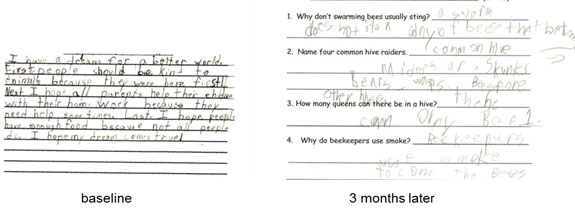SCHOOL RESOURCES
Symptom presentation, impact, and accommodations for students with PANS/PANDAS
Children with PANS/PANDAS have an abrupt and dramatic onset of OCD or Restrictive Eating Disorder plus additional symptoms from at least 2 of the following categories:
- Anxiety
- Emotional Lability/Rages
- Depression
- Behavioral Regression
- Deterioration in School Performance
- Sensory or Motor Abnormalities
- Sleep Disturbances Urinary Frequency
PANS stands for Pediatric Acute-onset Neuropsychiatric Syndrome and includes all cases of abrupt onset Obsessive-Compulsive Disorder (OCD) and/or restrictive eating disorder, accompanied by at least 2 co-morbid symptoms listed below. Unlike PANDAS, PANS does not require a streptococcal infection. While PANS is diagnosed clinically, the syndrome is believed to be the result of an immune response to one of a number of bacterial or viral infections that create autoimmune antibodies that affect the brain. The bacterial or viral infections include, but are not limited to, strep, Mycoplasma pneumonia, influenza, upper respiratory infections, and sinusitis. Psychosocial stresses can also exacerbate symptoms.
PANDAS is an abbreviation for Pediatric Autoimmune Neuropsychiatric Disorders Associated with Streptococcal infections. The term is used to describe a subset of children and adolescents who suddenly develop an acute onset of Obsessive Compulsive Disorder (OCD) and/or tic disorders, following an infection of Group A streptococcus, such as “Strep throat”. It is typically accompanied by additional symptoms also found in PANS.
Psychological testing of children with PANDAS has found impairments on a visual-spatial recall test, on measures of executive function, and on a dexterity test. Students with PANS/PANDAS may also experience:
✓ Handwriting changes
✓ Difficulty in math
✓ Memory issues
✓ Inability to focus
✓ Cognitive changes
✓ Anxiety due to obsessions and compulsions
✓ Decreased processing speed
✓ Severe separation anxiety
✓ Increased visits to the restroom
✓ Increased absences

1. Refer the child to be checked for strep and other infections.
2. Provide resources to physician, family, and school staff.
3. Be supportive of the child and family. This is a difficult time as they navigate a new illness and an increase in family stress.
4. Work closely with teachers, school counselors, and school based therapists (OT/PT/Speech) to create a healthy and productive environment for the child.
5. If strep is the known trigger, notify the family of new strep cases in the classroom. PANDAS children can worsen not only with re-infection, but also with exposure to strep.
6. Provide school accommodation ideas. A 504 plan or IEP may be needed. See list below.
Considerations for Health Care Professionals in the Education of PANS-Affected Students
Health care professionals, school staff, and families with PANDAS/PANS children are encouraged to work together to create a foundation for a successful school year. In order to help them navigate this process, PANDAS Physicians Network collaborated with Jamie Candelaria-Greene PhD, BCET to offer the resource, Considerations for Health Care Professionals in the Education of PANS-Affected Students.
This publication discusses the unique symptomatology and presentation of PANS in students, collaboration with the schools, and education amid COVID-19.
What is the difference between a 504 plan and an IEP?
A 504 plan typically includes accommodations and supports for a student with an identified disability. It does not need to be in writing. An IEP falls under the Individuals with Disabilities Education Act (IDEA). It is designed for students with disabilities that require individualized special education and related services. An IEP is a written plan that includes goals, tracks progress, and lists services to be provided from specialists.
Accommodation Ideas
Separation anxiety and OCD symptoms
Work with school psychologist, counselor, and school based therapists to develop a plan. Share with school the ERP (Exposure and Response Prevention) and CBT (Cognitive Behavioral Therapy) strategies that have been put in place.
Urinary problems
If the PANDAS/PANS child develops polyuria, the frequent need to urinate, and/or secondary enuresis, work to develop a plan that allows the child additional bathroom breaks as symptoms warrant.
ADHD-like symptoms (Attention Deficit/Hyperactivity Disorder)
Preferential seating (front of class), short and concise directions, additional time for assignments, and allowing the use of earbuds to help avoid distractions.
Restrictive eating
PANDAS/PANS children may experience restrictive eating due to fear of choking, vomiting, or contamination fears. Sensory sensitivities (texture and smell) may also negatively impact eating. Work with school to give extra time for lunch, provide a separate eating space, or allow the student to go home for lunch.
General
Do not take off for spelling or penmanship unless that is the task that is being tested on. Issues may include margin drifts and overall decline in dexterity and/or handwriting.
Orthographic issues
Copying tasks may be difficult for a child with PANDAS/PANS. Allow the use of a keyboard.
Poor physical and cognitive stamina, pain*
Shorter school day with reduced academic load, less homework, rest periods during the day (perhaps in the nurse’s office), and adapting physical education requirements
Dysgraphia or handwriting difficulties*
Having a note-taker in class, dictating tests and homework, enlarging worksheets, writing on large grid paper, and using a keyboard, voice-recognition software, or audio recorder
Dyscalculia and math difficulties*
Using a calculator or times table and working with a resource teacher or tutor
Slowed processing speed*
Decreasing the number and length of assignments, allowing extra time for tests and in-class assignments, and giving directions in written and oral form
*PANDAS/PANS Research Consortium treatment recommendations





